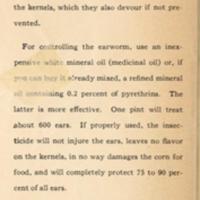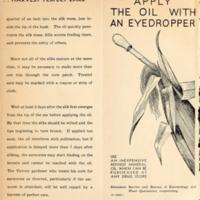Victory Gardeners Can Prevent Ear-Worms From Entering Their Corn
Title
Victory Gardeners Can Prevent Ear-Worms From Entering Their Corn
Subject
victory gardens
Excerpt
The corn earworm is the principal insect enemy of sweet corn. The larvae (or worms), hatching from eggs usually laid on the silks, feed in the interior silk mass and burrow toward the kernels, which they also devour if not prevented.
For controlling the earworm, use an inexpensive white mineral oil (medicinal oil) or, if you can buy it already mixed, a refined mineral oil containing 0.2 percent of pyrethrins. The latter is more effective. One pint will treat about 600 ears. If properly used, the insecticide will not injure the ears, leaves no flavor on the kernels, in no way damages the corn for food, and will completely protect 75 to 90 percent of all ears.
Use an ordinary glass medicine dropper that holds about 20 drops when half full. This amount is enough for a small ear. For a large ear, fill the dropper about three-fourths full. Larger amounts may reach the kernels and cause injury. Insert the medicine dropper about a quarter of an inch into the silk mass, just inside the tip of the husk. The oil quickly penetrates the silk mass, kills worms feeding there, and prevents the entry of others.
Since not all of the silks mature at the same time, it may be necessary to make more than one trip through the corn patch. Treated ears may be marked with a crayon or strip of cloth.
Wait at least 3 days after the silk first emerges from the tip of the ear before applying the oil. By that time the silks should be wilted and the tips beginning to turn brown. If applied too soon, the oil interferes with pollination, but if application is delayed more than 7 days after silking, the ear worms may start feeding on the kernels and cannot be reached with the oil. The Victory gardener who treats his corn for earworms as directed, particularly if the earworm is abundant, will be well repaid by a harvest of perfect ears.
For controlling the earworm, use an inexpensive white mineral oil (medicinal oil) or, if you can buy it already mixed, a refined mineral oil containing 0.2 percent of pyrethrins. The latter is more effective. One pint will treat about 600 ears. If properly used, the insecticide will not injure the ears, leaves no flavor on the kernels, in no way damages the corn for food, and will completely protect 75 to 90 percent of all ears.
Use an ordinary glass medicine dropper that holds about 20 drops when half full. This amount is enough for a small ear. For a large ear, fill the dropper about three-fourths full. Larger amounts may reach the kernels and cause injury. Insert the medicine dropper about a quarter of an inch into the silk mass, just inside the tip of the husk. The oil quickly penetrates the silk mass, kills worms feeding there, and prevents the entry of others.
Since not all of the silks mature at the same time, it may be necessary to make more than one trip through the corn patch. Treated ears may be marked with a crayon or strip of cloth.
Wait at least 3 days after the silk first emerges from the tip of the ear before applying the oil. By that time the silks should be wilted and the tips beginning to turn brown. If applied too soon, the oil interferes with pollination, but if application is delayed more than 7 days after silking, the ear worms may start feeding on the kernels and cannot be reached with the oil. The Victory gardener who treats his corn for earworms as directed, particularly if the earworm is abundant, will be well repaid by a harvest of perfect ears.
Creator
U.S. Department of Agriculture
Date
1943
Relation
AWI: Number 58
 An official website of the United States government.
An official website of the United States government.




